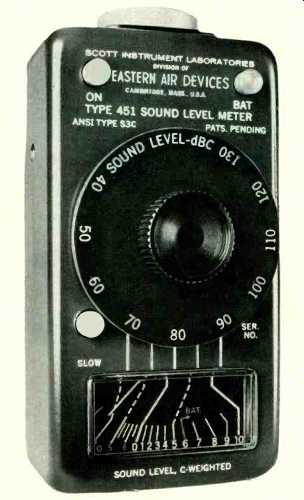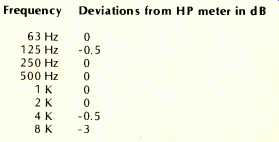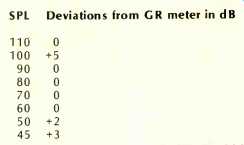
MANUFACTURER'S SPECIFICATIONS
Standards: Meets or exceeds all requirements of ANSI SI.4 1971 for Sound Level Meter, type S3c. Sound Level Range: 45 to 130 dB re 0.0002 dynes/cm^2.
Frequency Range: 30 Hz to 8 kHz; Standard C weighting per ANSI SI.4-1971.
Microphone: Omni-directional ceramic.
Meter: Taut-band movement gives 20 dB range without switching.
Battery: One 9-volt transistor radio type (Eveready # 216 or equivalent) gives approximately 200-hour operation.
Environmental: Operating temperature range of 15 to 150 degrees F. Storage temperature range of 0 to +165 degrees F and 0 to 95% relative humidity. All-metal case provides shielding in electrostatic fields. A magnetic field of 1 Oersted (80 A/m) at 60 Hz does not produce an on-scale reading.
Dimensions: 2 1/2 in. W x 5 in. L x 2 3/8 in. D overall.
Weight: 13 oz. net.
Price: $115.00.
The new Scott 451C sound level meter is a scaled down pocket sized version of Scott's earlier Model 4508. The unit can measure a large dynamic range with "C" weighting, which is the meter weighting closest to flat frequency response. The larger Scott Model 450B offers "A", "B", and "C" weighting for more analytical sound work. The 451C's wide dynamic range enables measurement of low level background noise as well as strong signals such as rock music at close range.
The meter is enclosed in a rugged, drawn aluminum case that has a removable rear cover for battery replacement. It is intended for operation with the left hand, leaving the right hand free to write down results or make signals with.
Besides the thumb-operated attenuator which selects the range used, three momentary-on push buttons are provided on the front face. The first energizes the instrument, the second enables a battery check and the third converts the normally "fast" meter response into "slow" for more aver aged readings. In the "fast" mode the meter responds like a VU meter. Calibration is set at the factory and Scott will re-calibrate at any time for $10.00. The instrument comes with a handsome leather storage pouch.
Test Results
Since a standard coupler-calibrator does not fit onto the Model 451C and since no adaptor is yet available for this instrument, we decided to compare its performance against a General Radio Model 1565A sound level meter set to "C" scale, having first calibrated it using a General Radio Model 1562A calibrator. To first check the frequency response of the 451C, we compared it against a calibrated Hewlett Packard Model 8058A sound level meter which utilizes a 1/2-in. condenser microphone. We played octave bands of pink noise and compared the response of the 451C to that of the HP 8058A. Table 1 shows the results to be excellent over the range that the 451C covers. "C" weighting has a 3 dB drop at 8 kHz, so that figure is accurate.

TABLE 1. Scott 451C frequency response relative to response of HP 8058A
sound level meter.
To check the accuracy of the meter, FET input stage and amplifier section, we compared the readings taken on the 451C with those from the GR Model 1565A, at the same location from the sound source, attenuating the sound source accurately by 10 dB steps. The results were excellent down to the lowest meter range where minor discrepancy was evident. See Table 2 for the data.

TABLE 2. Scott 451C attenuator accuracy as compared to General Radio Model
1 565A meter.
Using the 451C Holding the meter in the left hand, the thumb operates the "on" button, energizing the unit. Assuming one has set the range switch to the proper range, also with his thumb, a reading will be evident. To check the battery, the thumb must be extended so that in addition to pressing the red "on" button, it hits the green "battery" button. Once satisfactory battery condition has been established, we're ready for action. To use the meter's "slow" mode, it is necessary to press the black "slow" button. For some, the other hand must be pressed into action now. The whole business of momentary buttons can be a nuisance during use. For one thing, the meter down anywhere desirable during listing of noise readings. A hand-held meter can pick up noise due to its own motion and handling. A rocker switch is better for slow/fast operation, though the momentary will help conserve batteries. It is possible for the left hand to hold down both the "slow" and "on" switches though it is a bit awkward and uncomfortable.
The 20-dB scale is of respectable size but a bit crowded with number symbols. The ANSI standard, however, requires that all numbers be printed on the scale. The instrument does not have an electrical output so whatever is being measured cannot be recorded or fed to another analyzing instrument such as an octave analyzer or 'scope. The larger Model 450B has an output. Finally, a dust cap and strap would have been nice.
The Model 451C is good for measuring SPL in discotheques, noises from subways and trains, but not for cars because road noise has heavy low frequency components which need to be "A" weighted to be indicative of the perceived noise. It's good for measuring noisy neighbors and noise produced by portable appliances and machines. It's good for checking out the level in your favorite concert hall or rock festival seat, then comparing the readings with readings taken listening to your stereo system at home. We venture to say that in both cases the user is in for a numerical surprise.
For those needing "A" weighting, which more closely approximates the human ear response at low SPL, the Scott Model 451, costing $115, is available. General Radio and B&K instruments are more flexible in use but are more ex pensive still. For others merely interested in flat response reading across a wide dynamic range, this instrument fits the bill nicely, and is a third the price of the units used for comparison in these tests.
-Alex Rosner
(Audio magazine, Nov. 1974 )
Also see:
Realistic Sound Level Meter (Equip. Profile, Nov. 1978)
= = = =